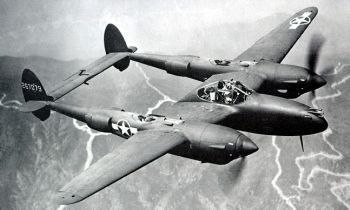
Publisher:
Bonnie King
CONTACT:
Newsroom@Salem-news.com
Advertising:
Adsales@Salem-news.com

~Truth~
~Justice~
~Peace~
TJP
Oct-21-2008 09:26

 TweetFollow @OregonNews
TweetFollow @OregonNews
Remains of WWII Pilot Recovered in France
Salem-News.comAn Army Air Force Lt. in a flight of 22 U.S. fighters was attacked by 80 German aircraft.
 The P-38 Lightning was one of the most highly regarded fighter aircraft in WWII. Photo: world-war-2-planes.com |
(WASHINGTON, D.C.) - The remains of a U.S. serviceman missing in action from World War II, have been identified and will be returned to his family for burial with full military honors.
2nd Lieutenant Ray D. Packard, U.S. Army Air Forces, of Atwood, California. He will be buried on October 22nd in Prescott, Arizona.
Representatives from the Army met with Ray Packard's next-of-kin to explain the recovery and identification process and to coordinate interment with military honors on behalf of the Secretary of the Army.
On August 25th, 1944, Lt. Packard was a pilot in a flight of 22 P-38 Lightning fighter aircraft that left the allied airfield at St. Lambert, France, to attack enemy airfields near Laon-Chambry, France.
Enroute to their target, the fighter group was intercepted by more than 80 German fighters near Beauvais, France. During the ensuing dogfight, 11 P-38s were shot down, including Ray Packard's which crashed 15 miles south of Beauvais near the town of Angy.
Five of the pilots escaped and evaded enemy capture and two were taken as prisoners of war. Of the four men who were missing in action, three were later recovered and identified, but Lt. Packard remained unaccounted-for.
In 1951, a U.S. Army Graves Registration Command team investigated the incident and interviewed a French citizen who said he recovered human remains from a P-38 crash site in Angy. The team also interviewed the mayor of Angy who said that the remains had been buried in a local cemetery, but had later been exhumed and he didn't know what happened after the disinterment. The team went to the crash site, but only found small pieces of aircraft wreckage.
In 2006, a Joint POW/MIA Accounting Command (JPAC) team traveled to Angy to investigate the incident. The team interviewed the son of the French citizen interviewed in 1951. He turned over to the team human remains and other non-biological evidence recovered from the crash site.
The team interviewed another French citizen, an aircraft wreckage hunter, who turned over remains and other evidence from an excavation that he conducted at the site.
In 2006 and 2007, JPAC teams conducted two excavations and recovered more human remains, aircraft wreckage, and material evidence including Ray Packard's identification tag.
Among other forensic identification tools and circumstantial evidence, scientists from JPAC used dental comparisons in the identification of 2nd Lt. Packard's remains.
Articles for October 20, 2008 | Articles for October 21, 2008 | Articles for October 22, 2008



googlec507860f6901db00.html
Salem-News.com:
Quick Links
DINING
Willamette UniversityGoudy Commons Cafe
Dine on the Queen
Willamette Queen Sternwheeler
MUST SEE SALEM
Oregon Capitol ToursCapitol History Gateway
Willamette River Ride
Willamette Queen Sternwheeler
Historic Home Tours:
Deepwood Museum
The Bush House
Gaiety Hollow Garden
AUCTIONS - APPRAISALS
Auction Masters & AppraisalsCONSTRUCTION SERVICES
Roofing and ContractingSheridan, Ore.
ONLINE SHOPPING
Special Occasion DressesAdvertise with Salem-News
Contact:AdSales@Salem-News.com
Terms of Service | Privacy Policy
All comments and messages are approved by people and self promotional links or unacceptable comments are denied.
[Return to Top]
©2025 Salem-News.com. All opinions expressed in this article are those of the author and do not necessarily reflect those of Salem-News.com.